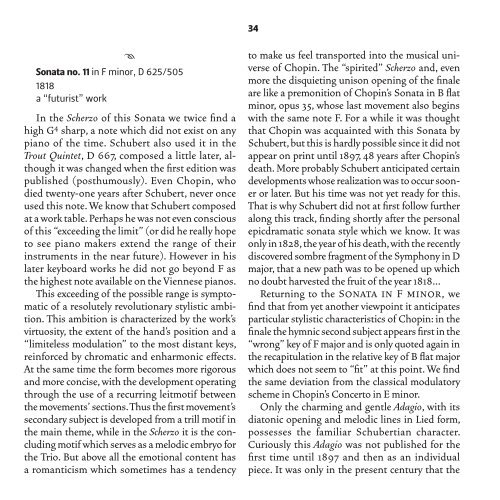Télécharger le livret - Outhere
Télécharger le livret - Outhere
Télécharger le livret - Outhere
You also want an ePaper? Increase the reach of your titles
YUMPU automatically turns print PDFs into web optimized ePapers that Google loves.
∆<br />
Sonata no. 11 in F minor, D 625/505<br />
1818<br />
a “futurist” work<br />
in the Scherzo of this Sonata we twice find a<br />
high G4 sharp, a note which did not exist on any<br />
piano of the time. Schubert also used it in the<br />
Trout Quintet, D 667, composed a litt<strong>le</strong> later, although<br />
it was changed when the first edition was<br />
published (posthumously). Even Chopin, who<br />
died twenty-one years after Schubert, never once<br />
used this note. We know that Schubert composed<br />
at a work tab<strong>le</strong>. Perhaps he was not even conscious<br />
of this “exceeding the limit” (or did he really hope<br />
to see piano makers extend the range of their<br />
instruments in the near future). However in his<br />
later keyboard works he did not go beyond F as<br />
the highest note availab<strong>le</strong> on the Viennese pianos.<br />
This exceeding of the possib<strong>le</strong> range is symptomatic<br />
of a resolutely revolutionary stylistic ambition.<br />
This ambition is characterized by the work’s<br />
virtuosity, the extent of the hand’s position and a<br />
“limite<strong>le</strong>ss modulation” to the most distant keys,<br />
reinforced by chromatic and enharmonic effects.<br />
At the same time the form becomes more rigorous<br />
and more concise, with the development operating<br />
through the use of a recurring <strong>le</strong>itmotif between<br />
the movements’ sections. Thus the first movement’s<br />
secondary subject is developed from a trill motif in<br />
the main theme, whi<strong>le</strong> in the Scherzo it is the concluding<br />
motif which serves as a melodic embryo for<br />
the Trio. But above all the emotional content has<br />
a romanticism which sometimes has a tendency<br />
34<br />
to make us feel transported into the musical universe<br />
of Chopin. The “spirited” Scherzo and, even<br />
more the disquieting unison opening of the fina<strong>le</strong><br />
are like a premonition of Chopin’s Sonata in B flat<br />
minor, opus 35, whose last movement also begins<br />
with the same note F. For a whi<strong>le</strong> it was thought<br />
that Chopin was acquainted with this Sonata by<br />
Schubert, but this is hardly possib<strong>le</strong> since it did not<br />
appear on print until 1897, 48 years after Chopin’s<br />
death. More probably Schubert anticipated certain<br />
developments whose realization was to occur sooner<br />
or later. But his time was not yet ready for this.<br />
That is why Schubert did not at first follow further<br />
along this track, finding shortly after the personal<br />
epicdramatic sonata sty<strong>le</strong> which we know. it was<br />
only in 1828, the year of his death, with the recently<br />
discovered sombre fragment of the Symphony in D<br />
major, that a new path was to be opened up which<br />
no doubt harvested the fruit of the year 1818…<br />
Returning to the Sonata in F minor, we<br />
find that from yet another viewpoint it anticipates<br />
particular stylistic characteristics of Chopin: in the<br />
fina<strong>le</strong> the hymnic second subject appears first in the<br />
“wrong” key of F major and is only quoted again in<br />
the recapitulation in the relative key of B flat major<br />
which does not seem to “fit” at this point. We find<br />
the same deviation from the classical modulatory<br />
scheme in Chopin’s Concerto in E minor.<br />
Only the charming and gent<strong>le</strong> Adagio, with its<br />
diatonic opening and melodic lines in Lied form,<br />
possesses the familiar Schubertian character.<br />
Curiously this Adagio was not published for the<br />
first time until 1897 and then as an individual<br />
piece. it was only in the present century that the


